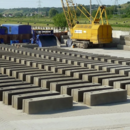Vibration Compaction Technology
Contents |
[edit] Introduction
Vibration compaction is one of the methods of manufacturing products from a concrete mix. This technology provides for the compaction of concrete mixtures through the combination of vibration and simultaneous pressure from above.
[edit] Using vibration compaction
For this manufacturing method, semi-dry hard concrete mixtures are used. Such a mixture has a smaller amount of water compared to the mobile mixture, which makes it less ductile.
For moulding by vibration compaction, the plasticity should be P1 with a cone slump of 1 – 4 cm. After completion of compaction, the mould is removed, and the product must continue to maintain its dimensions and appearance.
It is the rigidity of the mixture that ensures the filling of the mould under the action of vibration and its own mass. The traditional technology of vibration compaction involves moulding using deep vibrators. However, there are restrictions on the size of manufactured products.
[edit] Machine made concrete blocks
The process of making concrete block using machines consists of several steps. Concrete mixture is fed into the receiving hopper. Then the mould is filled with a mixture. Mounting loops are mounted in the locking device for moulding and electric vibrators are used to mould the block directly. The process takes approximately three to four minutes.
The technology of vibration compaction and the mobility of the concrete block making machines makes it possible to produce up to 120 blocks per shift.
--Nemp
[edit] Related articles on Designing Buildings Wiki
Featured articles and news
One of the most impressive Victorian architects. Book review.
RTPI leader to become new CIOB Chief Executive Officer
Dr Victoria Hills MRTPI, FICE to take over after Caroline Gumble’s departure.
Social and affordable housing, a long term plan for delivery
The “Delivering a Decade of Renewal for Social and Affordable Housing” strategy sets out future path.
A change to adoptive architecture
Effects of global weather warming on architectural detailing, material choice and human interaction.
The proposed publicly owned and backed subsidiary of Homes England, to facilitate new homes.
How big is the problem and what can we do to mitigate the effects?
Overheating guidance and tools for building designers
A number of cool guides to help with the heat.
The UK's Modern Industrial Strategy: A 10 year plan
Previous consultation criticism, current key elements and general support with some persisting reservations.
Building Safety Regulator reforms
New roles, new staff and a new fast track service pave the way for a single construction regulator.
Architectural Technologist CPDs and Communications
CIAT CPD… and how you can do it!
Cooling centres and cool spaces
Managing extreme heat in cities by directing the public to places for heat stress relief and water sources.
Winter gardens: A brief history and warm variations
Extending the season with glass in different forms and terms.
Restoring Great Yarmouth's Winter Gardens
Transforming one of the least sustainable constructions imaginable.
Construction Skills Mission Board launch sector drive
Newly formed government and industry collaboration set strategy for recruiting an additional 100,000 construction workers a year.
New Architects Code comes into effect in September 2025
ARB Architects Code of Conduct and Practice available with ongoing consultation regarding guidance.
Welsh Skills Body (Medr) launches ambitious plan
The new skills body brings together funding and regulation of tertiary education and research for the devolved nation.
Paul Gandy FCIOB announced as next CIOB President
Former Tilbury Douglas CEO takes helm.























